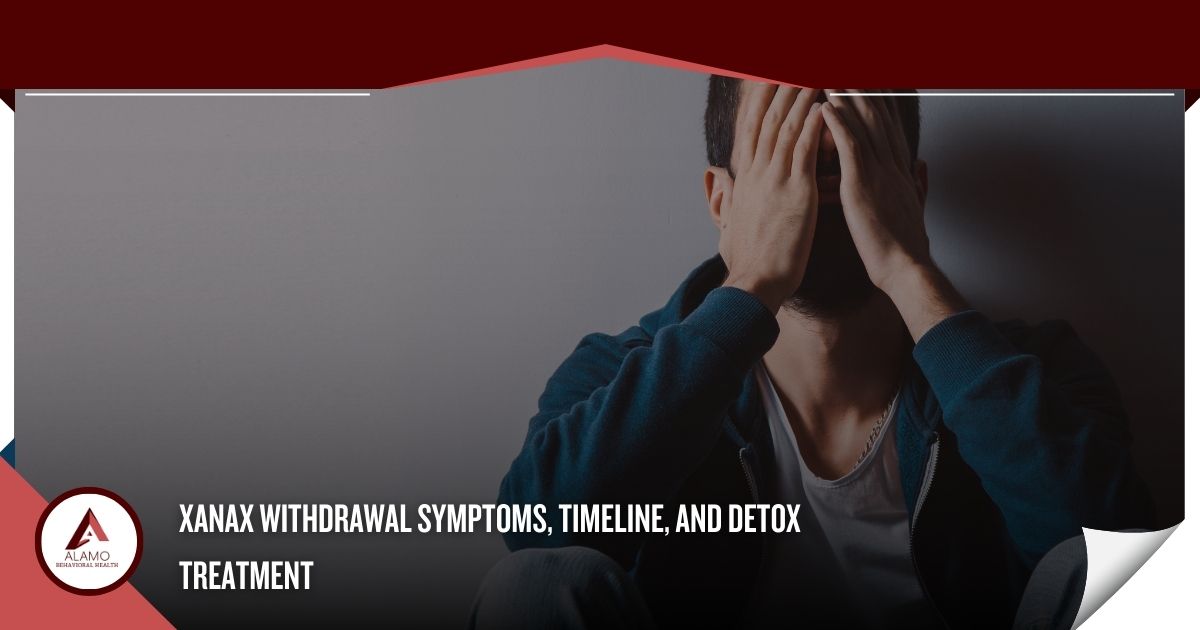Many people take prescription medications to treat or manage health conditions. Some prescription drugs have the potential for misuse and addiction, and millions of people develop prescription drug abuse each year.
Xanax (alprazolam) is a prescription drug used to treat anxiety and other mental health conditions.[1] It is the most commonly prescribed benzodiazepine for anxiety and panic disorders.[2] This commonly prescribed drug has an increased risk of misuse and addiction, even when people use it as prescribed.
People who misuse Xanax have an increased risk of severe, long-term complications, including addiction. Those with Xanax dependence require comprehensive treatment and ongoing support to avoid relapse.
This article will explore Xanax addiction and treatment. You will learn:
- The symptoms of Xanax withdrawal
- What happens at each stage of the Xanax withdrawal timeline
- What treatment to expect during Xanax detox
- How to recognize Xanax addiction
- Where to find effective treatment for addiction
If you are struggling with Xanax abuse or addiction, you are not alone. Reach out to the Alamo Behavioral Health specialists to explore our substance use disorder treatment programs or to schedule an intake assessment.
Xanax Addiction: Recognizing the Signs
Xanax is the brand name for a psychotropic drug called alprazolam. It belongs to a class of medications called benzodiazepines (benzos).
Doctors may prescribe benzodiazepines like Xanax to help patients manage the symptoms of anxiety disorders, panic disorders, sleep disorders, and other conditions. Xanax can relieve the disruptive symptoms of these conditions, which can include:
- Racing thoughts
- Panic attacks
- Agitation and restlessness
- GI symptoms
- Sleep issues, including insomnia
- Poor concentration
- Memory problems
Xanax calms brain activity by increasing the amount of gamma-aminobutyric acid (GABA) in the brain. Medical experts believe that higher GABA levels can result in less anxiety and more feelings of calm.[3]
People may experience sedation, relaxation, and euphoria while taking Xanax. Euphoria is an intense feeling of pleasure and well-being. People may like the way they feel when taking Xanax, which can lead to misuse.
Xanax misuse includes:
- Taking a larger dose than prescribed
- Taking Xanax more often than prescribed
- Using Xanax for a longer period than prescribed
Xanax misuse can lead to physical dependence. People who become addicted to Xanax typically require medical supervision and support to have a safe, complete detox from the drug.
Recognizing Xanax addiction early is critical for long-term recovery. People who misuse Xanax may experience significant behavioral, physical, and emotional changes, including:
- Disorientation
- Dizziness
- Irritability
- Aggression
- Memory problems
- Loss of coordination
- Sedation
People may do dishonest or illegal things to get Xanax after their prescription runs out, such as buying Xanax or having multiple prescriptions for it.
Xanax addiction can become life-threatening. Seek treatment as soon as you recognize a problem.
What are Xanax Withdrawal Symptoms
If someone develops a physical dependence on Xanax and then quits taking it “cold turkey,” they are likely to experience symptoms of withdrawal. Xanax is a short-acting benzodiazepine, and withdrawal symptoms may begin within just hours after the last dose.[4]
- Common withdrawal symptoms include:
- Tremors
- Nausea
- Insomnia
- Excessive sweating
- Agitation
- Irritability
- Mood swings
Detoxing from Xanax without professional support can be very difficult. Many people who attempt to detox independently will relapse before detox is complete. Care and support in a treatment center will increase the likelihood of completing detox.
How Long Does Xanax Withdrawal Last?
Many factors can affect how long the side effects and symptoms of withdrawal last. However, Xanax withdrawal symptoms typically follow a timeline.
Here is an overview of what symptoms and treatment to expect during each stage of the Xanax withdrawal timeline.
Days 1-3
The symptoms of withdrawal will typically begin within 24 hours of your last dose. Acute withdrawal symptoms might include:
- Nausea and vomiting
- Mood swings
- Elevated heart rate
- Insomnia
Your symptoms may worsen over the first three days of detox. During this time, the risk of complications, including seizures, is at its highest.
In a medically-supported detox program, mental health and medical professionals will assess your withdrawal symptoms. They will provide treatment to keep you safe and comfortable. Detox treatment may include:
- Medications to reduce the risk of complications and reduce withdrawal symptoms
- A secure environment to minimize triggers
- Mental health care and emotional support
- Round-the-clock access to medical treatment
Detox treatment programs can keep you safe and comfortable as you navigate the earliest days of recovery.
One week
Your symptoms will likely remain constant for the first week of your detox. New psychological symptoms, such as depression and anxiety, may develop. People who were taking prescription Xanax to manage an anxiety disorder may experience heightened anxiety during this stage.
Your detox treatment team will continue to assess and treat your symptoms with medications and mental health care.
Two weeks
Your physical symptoms may begin to improve as you enter the second week of detox. However, psychological symptoms, including insomnia, depression, and anxiety, will remain.
Many people experience intense cravings during this stage of detox. Continued treatment and support are necessary to prevent relapse. You may begin a comprehensive program consisting of mental health treatment, behavioral therapies, and education.
One month
Withdrawal symptoms typically resolve within a month of their last dose of Xanax. However, some people live with ongoing symptoms, including insomnia, headaches, and cravings, for longer periods. Continuing treatment and support can help you stay focused on long-term recovery.
Find Treatment Now
If you or someone you love struggles with prescription benzodiazepine abuse, including Xanax addiction, you are not alone. Contact the Alamo Behavioral Health specialists to learn about our holistic treatment programs or to schedule an intake assessment.
References:
- United States Food and Drug Administration (FDA): Xanax alprazolam tablets
- National Institutes of Health (NIH): A Review of Alprazolam Use, Misuse, and Withdrawal
- National Institutes of Health (NIH): Hooked on benzodiazepines: GABA receptor subtypes and addiction
- NIH: The benzodiazepine withdrawal syndrome





